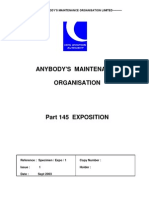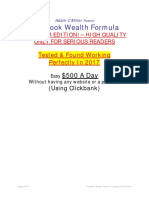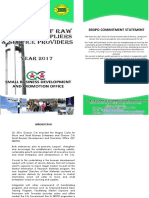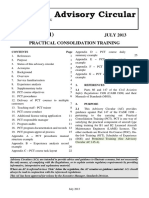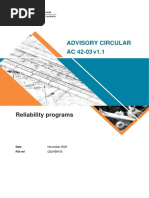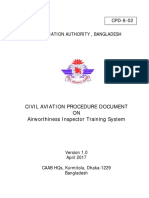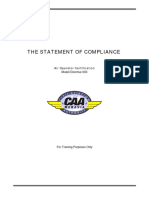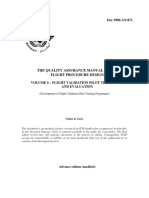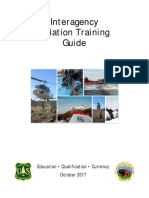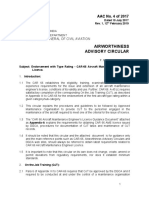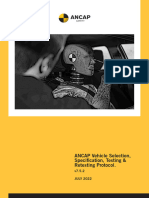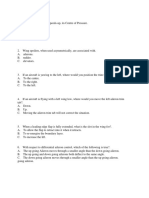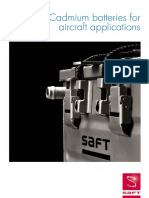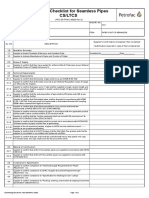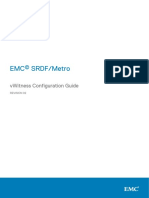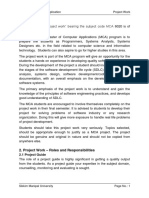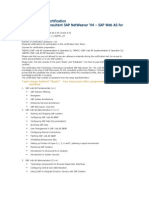066c07 PDF
066c07 PDF
Uploaded by
Dian SaputraCopyright:
Available Formats
066c07 PDF
066c07 PDF
Uploaded by
Dian SaputraOriginal Title
Copyright
Available Formats
Share this document
Did you find this document useful?
Is this content inappropriate?
Copyright:
Available Formats
066c07 PDF
066c07 PDF
Uploaded by
Dian SaputraCopyright:
Available Formats
ADVISORY CIRCULAR
AC 66-07
Practical training options for aircraft
type training and recording of recent
work experience
v1.2 – August 2016
PRACTICAL TRAINING OPTIONS FOR AIRCRAFT TYPE TRAINING
AND RECORDING OF RECENT WORK EXPERIENCE
Advisory Circulars are intended to provide advice and guidance to illustrate a means, but not necessarily the only
means, of complying with the Regulations, or to explain certain regulatory requirements by providing informative,
interpretative and explanatory material.
Advisory Circulars should always be read in conjunction with the relevant regulations.
Audience
This Advisory Circular (AC) applies to:
• licenced aircraft maintenance engineers (LAMEs)
• Part 145 approved maintenance organisations (AMO)
• Part 147 maintenance training organisations (MTO)
Purpose
This AC provides Part 66 of the Civil Aviation Safety Regulations 1998 (CASR) guidance material
pertaining to carrying out practical on course (POC) training and on-the-job training (OJT). Both of
these practical training methodologies provide a way of satisfying the practical component of
aircraft type rating training for B1 and B2 LAME licences. Another method is practical consolidation
training (PCT), the details of which can be seen in AC 147-1.
This AC also provides guidance to LAMEs on the options available for the recording of evidence of
their recent OJT work experience or maintenance tasks performed. This record may assist the
LAMEs in verifying that their Part 66 licence remains valid.
For further information
For further information on this AC, contact the Civil Aviation Safety Authority’s (CASA’s)
Maintenance Personnel Licensing branch (telephone 131 757).
Unless specified otherwise, all subregulations, regulations, divisions, subparts and parts
referenced in this AC are references to the Civil Aviation Safety Regulations 1998 (CASR).
AC 66-07 v1.2 August 2016 Page 1
PRACTICAL TRAINING OPTIONS FOR AIRCRAFT TYPE TRAINING
AND RECORDING OF RECENT WORK EXPERIENCE
Status
This version of the AC is approved by the Acting Manager, Airworthiness and Engineering Branch.
Note: Changes made in the current version are annotated with change bars.
Version Date Details
v1.2 August 2016 The following change has been made to this AC and is marked with a change
bar:
• addition of ATA 47 Nitrogen Generation Systems to the ‘Practical on
course’ task list table in Appendix A.
v1.1 May 2016 The following changes have been made to this AC with all new additions
annotated with shading:
• clarification of the objective of practical training
• clarification of the (Appendix A) practical on course task requirements that
must be completed and assessed as part of the approved practical
training.
(0) July 2013 This is the first AC to be issued on this subject.
AC 66-07 v1.2 August 2016 Page 2
PRACTICAL TRAINING OPTIONS FOR AIRCRAFT TYPE TRAINING
AND RECORDING OF RECENT WORK EXPERIENCE
Contents
1 Reference material 4
1.1 Acronyms 4
1.2 Definitions 4
1.3 References 5
1.4 Forms 5
2 Background 6
2.1 Overview 6
2.2 Type/task training and ratings 6
2.3 Required amounts of PCT, POC and OJT 7
2.4 Practical on course training 7
2.5 On-the-job-training 8
2.6 Assessment 9
Appendix A Practical on course task list 10
Appendix B Aircraft type practical experience and on-the-job training list of
tasks 16
Appendix C Recent work experience record 35
Appendix D SAMPLE OJT experience record log book 37
AC 66-07 v1.2 August 2016 Page 3
PRACTICAL TRAINING OPTIONS FOR AIRCRAFT TYPE TRAINING
AND RECORDING OF RECENT WORK EXPERIENCE
1 Reference material
1.1 Acronyms
The acronyms and abbreviations used in this AC are listed in the table below.
Acronym Description
AC Advisory Circular
AMC Acceptable Means of Compliance
AMO Approved Maintenance Organisation
ATA Air Transport Association
CAR Civil Aviation Regulations 1988
CASA Civil Aviation Safety Authority
CASR Civil Aviation Safety Regulations 1998
FADEC Full Authority Digital Engine Control
GM Guidance Material
POC Practical On Course Training
PCT Practical Consolidation Training
LAME Licenced Aircraft Maintenance Engineer
MOS Manual of Standards
MTO Maintenance Training Organisation
OJT On-the-Job Training
SOE Schedule of Experience
1.2 Definitions
Terms that have specific meaning within this AC are defined in the table below.
Term Definition
Supervising A person (the supervisor) is supervising the carrying out of maintenance
done by another person if the supervisor:
• is physically present at the place that the maintenance is being carried
out;
• is observing the maintenance being carried out to the extent necessary to
enable the supervisor to form an opinion as to whether the maintenance
is being carried out properly; and
• is available to give advice to, and answer questions about the
maintenance from, the person carrying it out.
AC 66-07 v1.2 August 2016 Page 4
PRACTICAL TRAINING OPTIONS FOR AIRCRAFT TYPE TRAINING
AND RECORDING OF RECENT WORK EXPERIENCE
1.3 References
Regulations
Regulations are available on the Federal Register of Legislation https://www.legislation.gov.au/
Document Title
Part 66 Continuing Airworthiness—aircraft engineer licences and ratings
Part 66 Manual of Part 66 Manual of Standards
Standards (MOS)
Part 147 Continuing Airworthiness—maintenance training organisations
Part 147 MOS Part 147 Manual of Standards
Advisory material
CASA's Advisory Circulars are available at http://www.casa.gov.au/AC
Document Title
Part 66 AMC/GM Acceptable Means of Compliance (AMC) and Guidance Material (GM) CASR
Part 66 Continuing Airworthiness—aircraft engineer licences and ratings
AC 147-1 Practical Consolidation Training
1.4 Forms
CASA’s forms are available at http://www.casa.gov.au/forms
Form number Title
CASA Form 465 Part 147 Maintenance Training Organisation and Part 145 Approved
Maintenance Organisation Notification of Training Outcomes
AMT logbook Standard Aircraft Maintenance Technician’s logbook - an American logbook
available for purchase at: http://www.actechbooks.com/subcategories/31/
AC 66-07 v1.2 August 2016 Page 5
PRACTICAL TRAINING OPTIONS FOR AIRCRAFT TYPE TRAINING
AND RECORDING OF RECENT WORK EXPERIENCE
2 Background
2.1 Overview
2.1.1 Under the previous regulation 31 of the Civil Aviation Regulations 1988 (CAR) licence
system, the practical consolidation training (PCT) program was established to provide
an alternative to schedules of experience (SOE) which would still satisfy the experience
requirements for grant of aircraft type ratings. The way in which PCT programs are
developed, approved and used can be seen in AC 147-1.
2.1.2 For a first rating either PCT or practical on course training (POC) is combined with an
on-the-job training (OJT) program to provide the experience required for a licence rating
in the B1 or B2 category. A licenced aircraft maintenance engineer (LAME) who already
holds a B1 or B2 type rating may utilise PCT training to meet the practical requirements
for their second or subsequent type rating in the same category as their first type rating,
or their first type rating in the other licence category (as a pre-requisite they must first
gain the underlying category). For example a B1 holder seeking their first B2 rating may
utilise PCT training to fully meet the practical requirements for the aircraft type rating.
2.1.3 POC, OJT and SOE may also be used in a standalone form to meet the practical
requirements for a rating.
2.1.4 SOE compiled to meet the B1 and B2 type rating experience requirements are another
acceptable means of compliance (AMC). 1
2.2 Type/task training and ratings
2.2.1 Type training consists of theoretical training and examination and practical training and
assessment and is described in sections 66.A.45, 66.A.50 and 66.A.55 of the
Part 66 MOS.
2.2.2 The practical element of type training may be conducted simultaneously with the
conduct of the theoretical element of type training or provided separately as a stand-
alone element. 2
2.2.3 Any practical training element, whether PCT, POC, OJT or SOE, consists of the
performance of representative maintenance tasks drawn from the type training and
examination syllabus, at the indicated level and to the assessment standards outlined in
Clause B – Practical element – assessment standard of Subpart 4 of Appendix III to the
Part 66 MOS.
2.2.4 Structured OJT is performed according to a type-specific program and includes training
in maintenance of the aircraft, rigging, adjustments, replacement of line replaceable
units, troubleshooting, rectification of minor defects and testing of systems covering
each element of the course.
1
For further details, see Appendix II of the CASR Part 66 AMC/ guidance material (GM) document.
2
For further details, see Appendix III of the Part 66 MOS
AC 66-07 v1.2 August 2016 Page 6
PRACTICAL TRAINING OPTIONS FOR AIRCRAFT TYPE TRAINING
AND RECORDING OF RECENT WORK EXPERIENCE
2.3 Required amounts of PCT, POC and OJT
2.3.1 The percentage of tasks to be covered for different combinations of PCT, POC and OJT
to satisfy the practical requirements of aircraft type training are provided in Appendix II
of the Part 66 AMC/GM document, located on the Civil Aviation Safety Authority’s
(CASA) website.
2.4 Practical on course training
2.4.1 POC is the practical experience gained by a LAME through their participation in an
aircraft type training course where the practical element of the training is run in
conjunction with the theory training.
2.4.2 The objective of practical training is to gain the required competence in performing safe
maintenance, inspections and routine work according to the maintenance manual and
other relevant instructions and tasks, as appropriate for the type of aircraft. For
example:
− troubleshooting
− repairs
− adjustments
− replacements
− rigging and functional checks.
It includes the awareness of the use of all technical literature and documentation for the
aircraft, the use of specialist/special tooling and test equipment for performing removal
and replacement of components and modules unique to type, including any on-wing
maintenance activity.
2.4.3 The practical on course task list can be found in the table at Appendix A. At least 50%
of the crossed items in the table, which are relevant to the particular aircraft type, must
be completed and assessed as part of the approved practical training.
2.4.4 Tasks marked with a cross represent subjects that would be mandatory for practical
training purposes to ensure that the operation, function, installation and safety
significance of key maintenance tasks are adequately addressed; particularly where
these cannot be fully explained by theoretical training alone.
2.4.5 Although the list details the minimum practical training subjects, other items may be
added where applicable to the particular aircraft type. As per the requirements of
Appendix III of the Part 66 MOS, tasks to be completed must be representative of the
aircraft and systems both in complexity and in the technical input required to complete
that task. While relatively simple tasks may be included, other more complex
maintenance tasks shall also be incorporated and undertaken as appropriate to the
aircraft type.
2.4.6 A type course developed to include the practical tasks outlined in the table at
Appendix A is subject to the normal type course approval process described in the
Part 66 MOS.
AC 66-07 v1.2 August 2016 Page 7
PRACTICAL TRAINING OPTIONS FOR AIRCRAFT TYPE TRAINING
AND RECORDING OF RECENT WORK EXPERIENCE
2.5 On-the-job-training
2.5.1 OJT is the aircraft maintenance experience gained by a LAME in the workplace. The
objective of OJT is to gain the required competence and experience in performing safe
maintenance. This type of training may or may not use structured learning processes.
2.5.2 OJT is usually delivered peer-to-peer and shall take place on the aircraft, or
aeronautical product, or at the workplace involving actual work task performance. OJT
may include both line and base maintenance tasks and must comply with the
requirements of Appendix III of the Part 66 MOS.
2.5.3 As per the requirements of Appendix III of the Part 66 MOS, OJT needs to cover a
cross section of tasks representative of the aircraft and systems both in complexity and
in the technical input required to complete that task. While relatively simple tasks may
be included, other more complex maintenance tasks shall also be incorporated and
undertaken as appropriate to the aircraft type. Each task shall be signed off by the
student, in addition to the workplace supervisor, peer or assessor. The tasks listed shall
refer to an actual job card/work order etc. The following data is addressed on the OJT
worksheets/logbook:
− trainee details (name, date of birth)
− approved maintenance organisation (AMO) and location
− name of supervisor and assessor (including licence number if applicable)
− description of task and job card/work order/tech log, date of task completion etc.
− aircraft type and aircraft registration
− licence rating applied for.
2.5.4 Type specific tasks may be substituted as applicable to the aircraft type concerned and
licence category. OJT should demonstrate a variety and cross section of tasks both in
terms of aircraft systems experience and in the complexity of the tasks performed. The
design of the OJT program should consider which tasks for an aircraft will be mandatory
irrespective of the experience reductions available by virtue of completing PCT or POC.
There will be aircraft specific tasks that every LAME will need to carry out, irrespective
of their experience.
2.5.5 Nomination of mandatory tasks
2.5.5.1 The AMO should nominate tasks from the tasks listed in Appendix B that will be
applicable to all LAME; and those required for less experienced LAME.
2.5.6 OJT record keeping
2.5.6.1 Type experience should be demonstrated by the submission (to the AMO assessor) of
OJT records or a logbook showing tasks performed by the applicant. The maintenance
organisation should provide applicants a schedule or plan indicating a list of tasks for a
type rating to be performed under supervision. A record of the tasks completed should
be entered into a logbook, which should be designed such that each or a group of tasks
may be countersigned by a workplace supervisor, peer or assessor.
2.5.6.2 The logbook format and its use should be clearly defined. A CASA SOE or a workplace
‘Recent work experience record’ worksheet can be utilised for the logging of OJT (refer
AC 66-07 v1.2 August 2016 Page 8
PRACTICAL TRAINING OPTIONS FOR AIRCRAFT TYPE TRAINING
AND RECORDING OF RECENT WORK EXPERIENCE
to Appendix C). This worksheet may be printed off and used by an individual LAME to
record evidence of their OJT experience or maintenance tasks performed.
2.5.6.3 ‘Sample forms’ for recording of an individual’s personal information, including details of
qualifications and training, authorisations and/or licences held and previous
employment history are provided at Appendix D.
2.5.6.4 Another document that may be used by a LAME for the recording of evidence of their
work experience or maintenance tasks performed is the Standard Aircraft Maintenance
Technician’s logbook, a United States of America publication, which meets regulatory
requirements of the Federal Aviation Administration (refer to advisory materials table at
section 1.3).
2.5.6.5 Additional information regarding AMC for use by a LAME for OJT can be found in the
Part 66 AMC/GM document, located on the CASA website.
2.5.7 Conduct of OJT
2.5.7.1 It is acceptable for confirmation of individual OJT task completion to be undertaken by a
direct supervisor. The Maintenance Training Organisation (MTO) Assessor or the AMO
Quality Manager should conduct a final review of the tasks undertaken and provide
confirmation of the completion of the required diversity, variety and quantity of OJT.
During OJT, the supervisor is to oversee the complete process, including task
completion and use of manuals and procedures during the performance of maintenance
in an appropriately approved maintenance environment.
2.6 Assessment
2.6.1 Where the OJT and its assessment are conducted under the responsibility of a
nominated Quality Manager within a Part 145 AMO, or an MTO assessor, an
adjustment is required to the Part 145 approval to describe the process. These
procedures should specify the requirements for assessor training and the assessment
process and should identify the assessor by name and position within the organisation.
The incorporation of an OJT program within an AMO’s operations requires a significant
change to the AMO's exposition procedures and requires CASA approval. Each OJT
program for each aircraft type will also require approval by CASA.
2.6.2 The OJT record should be submitted to the MTO with which an arrangement has been
made for assessment, or to the AMO Quality Manager. The final assessment of the OJT
that has been satisfactorily completed to the requirements outlined above should be
certified by either a Part 147 MTO assessor or the Part 145 Quality Manager.
2.6.3 When the OJT has been successfully completed, the MTO or the AMO Quality Manager
should complete the appropriate section of CASA Form 465 (category A, B1 or B2)
Notification to CASA of Training Outcome(s). The assessment may be performed task-
by-task or conducted as a final assessment at the end of the practical training and/or
OJT.
2.6.4 Assessment standards for the practical element of aircraft type training are detailed in
Clause B of Subpart 4 of Appendix III to the Part 66 MOS.
AC 66-07 v1.2 August 2016 Page 9
PRACTICAL TRAINING OPTIONS FOR AIRCRAFT TYPE TRAINING
AND RECORDING OF RECENT WORK EXPERIENCE
Appendix A
Practical on course task list
AC 66-07 v1.2 August 2016 Page 10
PRACTICAL TRAINING OPTIONS FOR AIRCRAFT TYPE TRAINING
AND RECORDING OF RECENT WORK EXPERIENCE
ATA B1/B2
locate Function/ Service Remove MEL Trouble
operate Ground Install Shoot
test Handle
Introduction Module
5 Time Limits X/X — — — — —
6 Dimensions/Areas X/X — — — — —
7 Lifting and Shoring X/X — — — — —
8 Levelling and Weighing X/X — X/X — — —
9 Towing and Taxiing X/X — X/X — — —
10 Parking and Mooring X/X — X/X — — —
11 Placards and Markings X/X — — — — —
12 Servicing X/X — X/X — — —
20 Standard practices – type X/X — X/X — — —
particular
Airframe Systems
21 Air Conditioning X/X X/X X/X — X/X X/X
21A Air Supply X/X X/X — — — —
21B Pressurization X/X X/X — — X/X X/X
21C Safety and Warning Devices X/X — X/X — — —
22 Auto Flight X/X —/X —/X —/X X/X —/X
23 Communications X/X —/X X/X —/X X/X —/X
24 Electrical Power X/X X/X X/X X/X X/X X/X
25 Equipment & Furnishings X/X X/X X/X X/X — —
25A Electronic Equipment including X/X X/X X/X X/X — —
emergency equipment
26 Fire Protection X/X X/X X/X X/X X/X X/X
27 Flight Controls X/X X/X X/— X/— X/— X/—
27A Flight Controls System Operation: X/X X/X X/— X/X X/— —/X
Electrical/Fly-by-Wire
28 Fuel Systems X/X X/X X/X X/— X/X X/—
28A Fuel Systems – monitoring and X/X X/X — —/X — —/X
indicating
29 Hydraulic Power X/X X/X X/X X/— X/X X/—
AC 66-07 v1.2 August 2016 Page 11
PRACTICAL TRAINING OPTIONS FOR AIRCRAFT TYPE TRAINING
AND RECORDING OF RECENT WORK EXPERIENCE
ATA B1/B2
locate Function/ Service Remove MEL Trouble
operate Ground Install Shoot
test Handle
29A Hydraulic Power – monitoring and X/X X/X — X/X X/X X/X
indicating
30 Ice & Rain Protection X/X X/X X/X — X/X X/X
31 Indicating/Recording Systems X/X X/X X/X X/X X/X X/X
31A Instrument Systems X/X X/X X/X X/X X/X X/X
32 Landing Gear X/X X/X X/X X/X X/X X/—
32A Landing Gear – monitoring and X/X X/X — X/X X/X X/X
indicating
33 Lights X/X X/X X/X X/X X/X —
34 Navigation X/X —/X X/X —/X X/X —/X
35 Oxygen X/— X/X X/X X/— — —
36 Pneumatic X/— X/X — X/X X/X X/X
36A Pneumatic – monitoring and X/X X/X X/X X/X X/X X/X
indicating
37 Vacuum X/— X/— — X/— X/— X/—
38 Water/Waste X/— X/X X/X — — —
41 Water Ballast X/— — — — — —
42 Integrated Modular Avionics X/X —/X —/X —/X —/X —/X
44 Cabin Systems X/X —/X —/X —/X —/X —/X
45 On-Board Maintenance Systems X/X X/X X/X X/X X/X X/X
46 Information Systems X/X —/X — —/X —/X —/X
47 Nitrogen Generation System X/X X/— X/— — X/— X/—
50 Cargo & Accessory Compartments X/X — X/— — — —
Airframe Structures
51 Standard Practices and Structures
(damage classification,
assessment and repair)
52 Fuselage Doors X/X X/— X/X — — —
53 Fuselage X/— — — — — X/—
54 Nacelles/Pylons X/— — — — — —
AC 66-07 v1.2 August 2016 Page 12
PRACTICAL TRAINING OPTIONS FOR AIRCRAFT TYPE TRAINING
AND RECORDING OF RECENT WORK EXPERIENCE
ATA B1/B2
locate Function/ Service Remove MEL Trouble
operate Ground Install Shoot
test Handle
55 Stabilisers X/— — — — — —
56 Windows X/— — — — — X/—
57 Wings X/— — — — — —
27A Flight Control Surfaces X/— — — — — X/—
Turbine and Piston Engine Modules
70 Standard Practices – Engines – — — X/X — — —
only type particular
70A Constructional arrangement and X/X — — — — —
operation (Installation Inlet,
Compressors, Combustion
Section, Turbine Section, Bearings
and Seals, Lubrication Systems)
Turbine Engines
70B Engine Performance — — — — — X/—
71 Power Plant X/— X/— X/X — — —
72 Engine Turbine / Turbo Prop / X/— — — — — —
Ducted Fan / Unducted fan
73 Engine Fuel and Control X/X X/— — — — —
73A Full Authority Digital Engine X/X X/X — X/X X/X X/X
Control (FADEC) Systems
74 Ignition X/X X/X — — — —
75 Air X/— — — X/— — X/—
76 Engine Controls X/— X/— — — — X/—
77 Engine Indicating X/X X/X — — X/X X/X
78 Exhaust X/— X/— — — X/— —
79 Oil X/— — X/— X/— — —
80 Starting X/— X/— — — X/— X/—
82 Water Injection X/— X/— — — — —
83 Accessory Gearboxes X/— — X/— — — —
84 Propulsion Augmentation X/— X/— — — — —
AC 66-07 v1.2 August 2016 Page 13
PRACTICAL TRAINING OPTIONS FOR AIRCRAFT TYPE TRAINING
AND RECORDING OF RECENT WORK EXPERIENCE
ATA B1/B2
locate Function/ Service Remove MEL Trouble
operate Ground Install Shoot
test Handle
Auxiliary Power Units (APU’s)
49 Auxiliary Power units (APU’s) X/X X/X X/X — — X/—
Piston Engines
70B Engine Performance — — — — — X/—
71 Power Plant X/— X/— X/X — — —
73 Engine Fuel and Control X/X X/— — — — —
73A FADEC Systems X/X X/X —/X X/X X/X X/X
74 Ignition X/X X/X — — — —
76 Engine Control X/— X/— — — — X/—
77 Engine Indicating X/X X/X — — X/X X/X
78 Exhaust X/— X/— — — X/— X/—
79 Oil X/— — X/— X/— — —
80 Starting X/— X/— — — X/— X/—
81 Turbines X/— X/— X/— X/— — X/—
82 Water Injection X/— X/— — — — —
83 Accessory Gearboxes X/— — X/— X/— — —
84 Propulsion Augmentation X/— X/— — — — —
Helicopters
18 Vibration and Noise Analysis X/— — — — — X/—
(blade tracking)
60 Standard Practices Rotor – only X/X — X/X — — —
type specific
62 Rotors X/— — X/— X/— — X/—
62A Rotors – monitoring and indicating X/X X/— X/— X/X X/— X/X
63 Rotor Drives X/— X/— — — — X/—
63A Rotor Drives - monitoring and X/X X/— — X/X X/— X/X
indicating
64 Tail Rotor X/— — X/— — — X/—
64A Tail Rotor - monitoring and X/X X/— — X/X X/— X/X
indicating
AC 66-07 v1.2 August 2016 Page 14
PRACTICAL TRAINING OPTIONS FOR AIRCRAFT TYPE TRAINING
AND RECORDING OF RECENT WORK EXPERIENCE
ATA B1/B2
locate Function/ Service Remove MEL Trouble
operate Ground Install Shoot
test Handle
65 Tail Rotor Drive X/— X/— — — — X/—
65A Tail Rotor Drive- monitoring and X/X X/— — X/X X/— X/X
indicating
66 Folding Blades / Pylon X/— X/— X/— — — X/—
67 Rotors Flight Controls X/— X/— X/— — X/— X/—
53 Airframe Structure (Helicopter) — — — — — —
Note: covered under Airframe
structures
25 Emergency Flotation Equipment X/X X/X X/X X/— X/— X/—
Propellers
60A Standard Practices - Propellers — — — X/— — —
61 Propellers/Propulsion X/X X/— X/— — X/— X/—
61A Propeller Construction X/X — X/— — — —
61B Pitch Control X/— X/— — X/— X/— X/—
61C Synchronising X/— X/— — — —/X X/—
61D Electronic Control X/X X/X X/X X/X X/X X/X
61E Ice Protection X/— X/— — X/— X/— X/—
61F Maintenance X/X X/X X/X X/X X/X X/X
AC 66-07 v1.2 August 2016 Page 15
PRACTICAL TRAINING OPTIONS FOR AIRCRAFT TYPE TRAINING
AND RECORDING OF RECENT WORK EXPERIENCE
Appendix B
Aircraft type practical experience and on-the-job
training list of tasks
AC 66-07 v1.2 August 2016 Page 16
PRACTICAL TRAINING OPTIONS FOR AIRCRAFT TYPE TRAINING
AND RECORDING OF RECENT WORK EXPERIENCE
B.1 Acronyms used in this appendix
Acronym Description
ABC Automatic Boost Control
ADF Automatic Direction Finder
ADI Attitude Direction Indicator
AMC Automatic Mixture Control
AMM Aircraft Maintenance Manual
APU Auxiliary Power Unit
ATA Air Transport Association
ATC Air Traffic Control
AVM Avionics Monitor
CFDIU Centralised Fault Display Interface Unit
CMU Communication Management Unit
DME Distance Measuring Equipment
ECU Engine Control Unit
EIS Electronic Instrument System
ELT Emergency Locator Transmitter
ESDS Emergency Shut Down System
FADEC Full Authority Digital Engine Control
FCU Flight Control Unit
FDR Flight Data Recorder
GPS Global Positioning System
HIRF High Intensity Radio Frequency
HP High Pressure
HSI Horizon Situation Indicator
LRU Line Replaceable Unit (avionic)
PRT Power Recovery Turbine
PTU Parallel Transfer Unit
RPM Revolutions per Minute
SelCal Selective Calling System
TAT Turbine Air Temperature
TCAS Traffic Alert and Collision Avoidance System
THS Trimmable Horizontal Stabilizer
VOR VHF Omni-directional Radio Range
AC 66-07 v1.2 August 2016 Page 17
PRACTICAL TRAINING OPTIONS FOR AIRCRAFT TYPE TRAINING
AND RECORDING OF RECENT WORK EXPERIENCE
Acronym Description
VSWR Voltage Standing Wave Ratio
B.2 ATA 5 Time limits/Maintenance Checks
100 hour check (general aviation aircraft)
“B” or “C” check (transport category aircraft)
Assist carrying out a scheduled maintenance check i.a.w. the Aircraft Maintenance Manual
(AMM)
Review Aircraft Maintenance Log for correct completion
Review records for compliance with airworthiness directives
Review records for compliance with aeronautical product life limits
Procedure for inspection following heavy landing
Procedure for inspection following lightning strike
ATA 6 Dimensions/Areas
Locate aeronautical product(s) by zone/station number
Perform symmetry check
ATA 7 Lifting and Shoring
Assist in:
• jack aircraft nose or tail wheel;
• jack complete aircraft; and
• sling or trestle major aeronautical product.
ATA 8 Levelling/Weighing
Level aircraft
Weigh aircraft
Prepare weight and balance amendment
Check aircraft against equipment list
ATA 9 Towing and Taxiing
Prepare aircraft for towing
Tow aircraft
Be part of aircraft towing team
AC 66-07 v1.2 August 2016 Page 18
PRACTICAL TRAINING OPTIONS FOR AIRCRAFT TYPE TRAINING
AND RECORDING OF RECENT WORK EXPERIENCE
ATA 10 Parking and Mooring
Tie down aircraft
Park, secure and cover aircraft
Position aircraft in maintenance dock
Secure rotor blades
ATA 11 Placards and Markings
Check aircraft for correct placards
Check aircraft for correct markings
ATA 12 Servicing
Refuel aircraft
Defuel aircraft
Carry out tank to tank fuel transfer
Check/adjust tire pressures
Check/replenish oil level
Check/replenish hydraulic fluid level
Check/replenish accumulator pressure
Charge Pneumatic System
Grease aircraft
Connect ground power
Service toilet/potable water system
Perform pre-flight/daily check
ATA 18 Vibration and Noise Analysis
Analyse helicopter vibration problem
Analyse noise spectrum
Analyse engine vibration
ATA 21 Air Conditioning
Replace combustion heater
Replace flow control valve
Replace outflow valve
Replace safety valve
Replace vapour cycle unit
Replace air cycle unit
AC 66-07 v1.2 August 2016 Page 19
PRACTICAL TRAINING OPTIONS FOR AIRCRAFT TYPE TRAINING
AND RECORDING OF RECENT WORK EXPERIENCE
Replace cabin blower
Replace heat exchanger
Replace pressurisation controller
Clean outflow valves
Deactivate/reactivate cargo isolation valve
Deactivate/reactivate avionics ventilation components
Check operation of Air Conditioning/Heating System
Check operation of Pressurisation System
Troubleshoot faulty system
ATA 22 Auto Flight
Install servos
Rig bridle cables
Replace controller
Replace amplifier
Replacement of the Auto Flight System Line Replaceable Unit (LRUs) in case of the fly-by-wire
aircraft
Check operation of auto-pilot
Check operation of auto-throttle/auto-thrust
Check operation of yaw damper
Check and adjust servo clutch
Perform autopilot gain adjustments
Perform mach trim functional check
Troubleshoot faulty system
Check Autoland System
Check Flight Management Systems
Check Stability Augmentation System
ATA 23 Communications
Replace VHF com unit
Replace HF com unit
Replace existing antenna
Replace static discharge wicks
Check operation of radios
Perform antenna Voltage Standing Wave Ratio (VSWR) check
AC 66-07 v1.2 August 2016 Page 20
PRACTICAL TRAINING OPTIONS FOR AIRCRAFT TYPE TRAINING
AND RECORDING OF RECENT WORK EXPERIENCE
Perform Selective Calling System (SelCal) operational check
Perform operational check of Passenger Address (PA) System
Functionally check Audio Integrating System
Repair coaxial cable
Troubleshoot faulty system
ATA 24 Electrical Power
Charge lead/acid battery
Charge Ni-Cad battery
Check battery capacity
Deep-cycle Ni-Cad battery
Replace integrated drive/generator/alternator
Replace switches
Replace circuit breakers
Adjust voltage regulator
Change voltage regulator
Amend electrical load analysis report
Repair/replace electrical feeder cable
Troubleshoot faulty system
Perform functional check of integrated drive/generator/alternator
Perform functional check of voltage regulator
Perform functional check of Emergency Generation System
ATA 25 Equipment/Furnishings
Replace carpets
Replace crew seats
Replace passenger seats
Check inertia reels
Check seats/belts for security
Check emergency equipment
Check Emergency Locator Transmitter (ELT) for compliance with regulations
Repair toilet waste container
Remove and install ceiling and sidewall panels
Repair upholstery
Change cabin configuration
AC 66-07 v1.2 August 2016 Page 21
PRACTICAL TRAINING OPTIONS FOR AIRCRAFT TYPE TRAINING
AND RECORDING OF RECENT WORK EXPERIENCE
Replace Cargo Loading System actuator
Test Cargo Loading System
Replace escape slides/ropes
ATA 26 Fire Protection
Check fire bottle contents
Check/test operation of Fire/Smoke Detection and Warning System
Check cabin fire extinguisher contents
Check Lavatory Smoke Detector System
Check cargo panel sealing
Install new fire bottle
Replace fire bottle squib
Troubleshoot faulty system
Inspect Engine Fire Wire Detection Systems
ATA 27 Flight Controls
Inspect primary flight controls and related aeronautical products i.a.w AMM
Extending/retracting flaps and slats
Replace horizontal stabiliser
Replace spoiler/lift dumper
Replace elevator
Deactivation/reactivation of aileron servo control
Replace aileron
Replace rudder
Replace trim tabs
Install control cable and fittings
Replace slats
Replace flaps
Replace powered flying control unit
Replace flap actuator
Rig primary flight controls
Adjust trim tab
Adjust control cable tension
Check control range and direction of movement
Check for correct assembly and locking
AC 66-07 v1.2 August 2016 Page 22
PRACTICAL TRAINING OPTIONS FOR AIRCRAFT TYPE TRAINING
AND RECORDING OF RECENT WORK EXPERIENCE
Troubleshoot faulty system
Functional test of primary flight controls
Functional test of Flap System
Operational test of the side stick assembly
Operational test of the Trimmable Horizontal Stabilizer (THS)
THS System wear check
ATA 28 Fuel
Water Drain System (operation)
Replace booster pump
Replace fuel selector
Replace fuel tank cells
Replace/test fuel control valves
Replace magnetic fuel level indicators
Replace water drain valve
Check / calculate fuel contents manually
Check filters
Flow Check System
Check calibration of fuel quantity gauges
Check operation feed/selectors
Check operation of Fuel Dump/Jettison System
Fuel transfer between tanks
Pressure de-fuel
Pressure re-fuel (manual control)
Deactivation / reactivation of the fuel valves (transfer de-fuel, X-feed, re-fuel)
Troubleshoot faulty system
ATA 29 Hydraulics
Replace engine driven pump
Check/replace case drain filter
Replace standby pump
Replace hydraulic motor pump/generator
Replace accumulator
Check operation of shut off valve
Check filters/clog indicators
AC 66-07 v1.2 August 2016 Page 23
PRACTICAL TRAINING OPTIONS FOR AIRCRAFT TYPE TRAINING
AND RECORDING OF RECENT WORK EXPERIENCE
Check Indicating Systems
Perform functional checks
Pressurisation/depressurisation of the Hydraulic System
Parallel Transfer Unit (PTU) operation
Replacement of PTU
Troubleshoot faulty system
ATA 30 Ice and Rain Protection
Replace pump
Replace timer
Inspect repair propeller deice boot
Test Propeller De-icing System
Inspect/test wing leading edge de-icer boot
Replace anti-ice/deice valve
Install wiper motor
Check operation of systems
Operational test of the pitot-probe ice protection
Operational test of the Turbine Air Temperature (TAT) ice protection
Operational test of the Wing Ice Protection System
Assistance to the operational test of the engine air-intake ice protection (engines in operation)
Troubleshoot faulty system
ATA 31 Indicating/Recording Systems
Replace Flight Data Recorder (FDR)
Replace cockpit voice recorder
Replace clock
Replace master caution unit
Replace FDR
Perform FDR data retrieval
Troubleshoot faulty system
Implement Emergency Shut Down System (ESDS) procedures
Inspect for High Intensity Radio Frequency (HIRF) requirements
Start/stop Electronic Instrument System (EIS) procedure
Bite test of the Centralised Fault Display Interface Unit (CFDIU)
Ground scanning of the Central Warning System
AC 66-07 v1.2 August 2016 Page 24
PRACTICAL TRAINING OPTIONS FOR AIRCRAFT TYPE TRAINING
AND RECORDING OF RECENT WORK EXPERIENCE
ATA 32 Landing Gear
Build up wheel
Replace main wheel
Replace nose wheel
Replace steering actuator
Replace truck tilt actuator
Replace gear retraction actuator
Replace uplock/downlock assembly
Replace shimmy damper
Rig nose wheel steering
Functional test of the Nose Wheel Steering System
Replace shock strut seals
Servicing of shock strut
Replace brake unit
Replace brake control valve
Bleed brakes
Replace brake fan
Test anti-skid unit
Test gear retraction
Change bungees
Adjust micro switches/sensors
Charge struts with oil and air
Troubleshoot faulty system
Test Auto-Brake System
Replace rotorcraft skids
Replace rotorcraft skid shoes
Pack and check floats
Flotation equipment
Check/test emergency blowdown (emergency landing gear extension)
Operational test of the landing gear doors
ATA 33 Lights
Repair/replace rotating beacon
Repair/replace landing lights
AC 66-07 v1.2 August 2016 Page 25
PRACTICAL TRAINING OPTIONS FOR AIRCRAFT TYPE TRAINING
AND RECORDING OF RECENT WORK EXPERIENCE
Repair/replace navigation lights
Repair/replace interior lights
Replace ice inspection lights
Repair/replace logo lights
Repair/replace Emergency Lighting System
Perform Emergency Lighting System checks
Troubleshoot faulty system
ATA 34 Navigation
Calibrate magnetic direction indicator
Replace airspeed indicator
Replace altimeter
Replace air data computer
Replace VHF Omni-directional Radio Range (VOR) unit
Replace Attitude Direction Indicator (ADI)
Replace Horizontal Situation Indicator (HSI)
Check Pitot Static System for leaks
Check operation of directional gyroscope
Functional check Weather Radar
Functional check Doppler
Functional check Traffic Alert and Collision Avoidance System (TCAS)
Functional check Distance Measuring Equipment (DME)
Functional check Air Traffic Control (ATC) Transponder
ATA 34 Navigation (continued)
Functional check Flight Director System
Functional check Inertial Navigation System
Complete quadrangle error correction of Automatic Direction Finder (ADF) System
Update Flight Management System database
Check calibration of pitot static instruments
Check calibration of Pressure Altitude Reporting System
Troubleshoot faulty system
Check Marker Systems
Compass replacement direct/indirect
Check Satcom
AC 66-07 v1.2 August 2016 Page 26
PRACTICAL TRAINING OPTIONS FOR AIRCRAFT TYPE TRAINING
AND RECORDING OF RECENT WORK EXPERIENCE
Check Global Positioning System (GPS)
Test Avionics Monitor (AVM)
ATA 35 Oxygen
Inspect on board oxygen equipment
Purge and recharge Oxygen System
Replace regulator
Replace oxygen generator
Test crew Oxygen System
Perform Auto Oxygen System deployment check
Troubleshoot faulty system
ATA 36 Pneumatic Systems
Replace filter
Replace air shut off valve
Replace pressure regulating valve
Replace compressor
Recharge dessicator
Adjust regulator
Check for leaks
Troubleshoot faulty system
ATA 37 Vacuum Systems
Inspect the Vacuum System i.a.w AMM
Replace vacuum pump
Check/replace filters
Adjust regulator
Troubleshoot faulty system
ATA 38 Water/Waste
Replace water pump
Replace tap
Replace toilet pump
Perform water heater functional check
Troubleshoot faulty system
Inspect waste bin flap closure
AC 66-07 v1.2 August 2016 Page 27
PRACTICAL TRAINING OPTIONS FOR AIRCRAFT TYPE TRAINING
AND RECORDING OF RECENT WORK EXPERIENCE
ATA 45 Central Maintenance System
Retrieve data from the Communication Management Unit (CMU)
Replace CMU
Perform Bite check
Troubleshoot faulty system
ATA 49 Auxiliary Power Unit (APU)
Removal/installation of the APU
Removal/installation of the inlet guide-vane actuator
Operational test of the APU emergency shut-down test
Operational test of the APU
ATA 51 Structures
Assessment of damage
Sheet metal repair
Fibre glass repair
Wooden repair
Fabric repair
Recover fabric control surface
Treat corrosion
Apply protective treatment
ATA 52 Doors
Inspect passenger door i.a.w AMM
Rig/adjust locking mechanism
Adjust Air Stair System
Check operation of emergency exits
Test Door Warning System
Troubleshoot faulty system
Remove and install passenger door i.a.w. AMM
Remove and install emergency exit i.a.w. AMM
Inspect cargo door i.a.w. AMM
ATA 56 Windows
Replace windshield
Replace direct vision window
AC 66-07 v1.2 August 2016 Page 28
PRACTICAL TRAINING OPTIONS FOR AIRCRAFT TYPE TRAINING
AND RECORDING OF RECENT WORK EXPERIENCE
Replace cabin window
Repair transparency
ATA 57 Wings
Skin repair
Recover fabric wing
Replace tip
Replace rib
Replace integral fuel tank panel
Check incidence/rig
ATA 61 Propeller
Assemble prop after transportation
Replace propeller
Replace governor
Adjust governor
Perform static functional checks
Check operation during ground run
Check track
Check setting of micro switches
Assessment of blade damage i.a.w. AMM
Dynamically balance prop
Troubleshoot faulty system
ATA 62 Main Rotors
Install rotor assembly
Replace blades
Replace damper assembly
Check track
Check static balance
Check dynamic balance
Troubleshoot
ATA 63 Rotor Drive
Replace mast
Replace drive coupling
AC 66-07 v1.2 August 2016 Page 29
PRACTICAL TRAINING OPTIONS FOR AIRCRAFT TYPE TRAINING
AND RECORDING OF RECENT WORK EXPERIENCE
Replace clutch/freewheel unit
Replace drive belt
Install main gearbox
Overhaul main gearbox
Check gearbox chip detectors
ATA 64 Tail Rotors
Install rotor assembly
Replace blades
Troubleshoot
ATA 65 Tail Rotor Drive
Replace bevel gearbox
Replace universal joints
Overhaul bevel gearbox
Install drive assembly
Check chip detectors
Check/install bearings and hangers
Check/service/assemble flexible couplings
Check alignment of drive shafts
Install and rig drive shafts
ATA 67 Rotorcraft Flight Controls
Install swash plate
Install mixing box
Adjust pitch links
Rig Collective System
Rig Cyclic System
Rig Anti-Torque System
Check controls for assembly and locking
Check controls for operation and sense
Troubleshoot faulty system
ATA 71 Power Plant
Build up Engine Control unit (ECU)
Replace engine
AC 66-07 v1.2 August 2016 Page 30
PRACTICAL TRAINING OPTIONS FOR AIRCRAFT TYPE TRAINING
AND RECORDING OF RECENT WORK EXPERIENCE
Repair cooling baffles
Repair cowling
Adjust cowl flaps
Repair faulty wiring
Troubleshoot
Assist in dry motoring check
Assist in wet motoring check
Assist in engine start (manual mode)
ATA 72 Piston Engines
Remove/install reduction gear
Check crankshaft run-out
Check tappet clearance
Check compression
Extract broken stud
Install helicoil
Perform ground run
Establish/check reference RPM
Troubleshoot
ATA 72 Turbine Engines
Replace module
Replace fan blade
Hot section inspection/boroscope check
Carry out engine/compressor wash
Carry out engine dry cycle
Engine ground run
Establish reference power
Trend monitoring/gas path analysis
Troubleshoot
ATA 73 Fuel and Control, Piston
Replace engine driven pump
Adjust Automatic Mixture Control (AMC)
Adjust Automatic Boost Control (ABC)
AC 66-07 v1.2 August 2016 Page 31
PRACTICAL TRAINING OPTIONS FOR AIRCRAFT TYPE TRAINING
AND RECORDING OF RECENT WORK EXPERIENCE
Install carburettor/injector
Adjust carburettor/injector
Clean injector nozzles
Replace primer line
Check carburettor float setting
Troubleshoot faulty system
ATA 73 Fuel and Control, Turbine
Replace Flight Control Unit (FCU)
Replace Engine Electronic Control Unit - Full Authority Digital Engine Control (FADEC)
Replace Fuel Metering Unit (FADEC)
Replace engine driven pump
Clean/test fuel nozzles
Clean/replace filters
Adjust FCU
Troubleshoot faulty system
Functional test of FADEC
ATA 74 Ignition Systems, Piston
Change magneto
Change ignition vibrator
Change plugs
Test plugs
Check H.T. leads
Install new leads
Check timing
Check system bonding
Troubleshoot faulty system
ATA 74 Ignition Systems, Turbine
Perform functional test of the Ignition System
Check glow plugs/ignitors
Check H.T. leads
Check ignition unit
Replace ignition unit
AC 66-07 v1.2 August 2016 Page 32
PRACTICAL TRAINING OPTIONS FOR AIRCRAFT TYPE TRAINING
AND RECORDING OF RECENT WORK EXPERIENCE
Troubleshoot faulty system
ATA 76 Engine Controls
Rig thrust lever
Rig RPM control
Rig mixture High Pressure (HP) cock lever
Rig power lever
Check control sync (multi-eng)
Check controls for correct assembly and locking
Check controls for range and direction of movement
Adjust pedestal micro-switches
Troubleshoot faulty system
ATA 77 Engine Indicating
Replace engine instruments(s)
Replace oil temperature bulb
Replace thermocouples
Check calibration
Troubleshoot faulty system
ATA 78 Exhaust, Piston
Replace exhaust gasket
Inspect welded repair
Pressure check cabin heater muff
Troubleshoot faulty system
ATA 78 Exhaust, Turbine
Change jet pipe
Change shroud assembly
Install trimmers
Inspect/replace thrust reverser
Replace thrust reverser component
Deactivate/reactivate thrust reverser
Operational test of the Thrust Reverser System
ATA 79 Oil
Change oil
AC 66-07 v1.2 August 2016 Page 33
PRACTICAL TRAINING OPTIONS FOR AIRCRAFT TYPE TRAINING
AND RECORDING OF RECENT WORK EXPERIENCE
Check filter(s)
Adjust pressure relief valve
Replace oil tank
Replace oil pump
Replace oil cooler
Replace firewall shut off valve
Perform oil dilution test
Troubleshoot faulty system
ATA 80 Starting
Replace starter
Replace start relay
Replace start control valve
Check cranking speed
Troubleshoot faulty system
ATA 81 Turbines, Piston Engines
Replace Power Recovery Turbine (PRT)
Replace turbo-blower
Replace heat shields
Replace waste gate
Adjust density controller
ATA 82 Engine Water Injection
Replace water/methanol pump
Flow check Water/Methanol System
Adjust water/methanol control unit
Check fluid for quality
Troubleshoot faulty system
ATA 83 Accessory Gear Boxes
Replace gearbox
Replace drive shaft
Check inspect magnetic chip detector
AC 66-07 v1.2 August 2016 Page 34
PRACTICAL TRAINING OPTIONS FOR AIRCRAFT TYPE TRAINING
AND RECORDING OF RECENT WORK EXPERIENCE
Appendix C
Recent work experience record
AC 66-07 v1.2 August 2016 Page 35
PRACTICAL TRAINING OPTIONS FOR AIRCRAFT TYPE TRAINING
AND RECORDING OF RECENT WORK EXPERIENCE
LOCATION TYPE OF
ACTIVITY
TASK DATE A/C TYPE & EMPLOYER SUPERVISOR / ASSESSOR / Lic No:
SUPERVISE
CATEGORY
A / B1 / B2 /
A/C REGO PEER (if applicable)
RELEASE
PERFOM
BASE
LINE
SURNAME SIGNATURE
Note: To knowingly make a false statement is an offence against the Criminal Code Act 1995.
I hereby declare that the information given on this form true in every respect.
Signature …………………......................................... Date ..........................
AC 66-07 v1.2 August 2016 Page 36
PRACTICAL TRAINING OPTIONS FOR AIRCRAFT TYPE TRAINING
AND RECORDING OF RECENT WORK EXPERIENCE
Appendix D
SAMPLE
OJT experience record log book
AC 66-07 v1.2 August 2016 Page 37
PRACTICAL TRAINING OPTIONS FOR AIRCRAFT TYPE TRAINING
AND RECORDING OF RECENT WORK EXPERIENCE
OJT experience record - log book
Personal details
SURNAME
GIVEN NAME(S)
DATE OF BIRTH
NATIONALITY
ADDRESS
STATE POSTCODE
Change of address
ADDRESS
STATE POSTCODE
ADDRESS
STATE POSTCODE
ADDRESS
STATE POSTCODE
AC 66-07 v1.2 August 2016 Page 38
PRACTICAL TRAINING OPTIONS FOR AIRCRAFT TYPE TRAINING
AND RECORDING OF RECENT WORK EXPERIENCE
Qualifications / training
QUALIFICATION/COURSE TRAINING START DATE FINISH DATE
TITLE ORGANISATION/SCHOOL
REMARKS
CERTIFIED BY
Authorisations / licences
AUTHORISATION / LICENCE AUTHORISING / LICENSING DATE ISSUED
ORGANISATION
AC 66-07 v1.2 August 2016 Page 39
PRACTICAL TRAINING OPTIONS FOR AIRCRAFT TYPE TRAINING
AND RECORDING OF RECENT WORK EXPERIENCE
Employment history
EMPLOYER NAME
ACN No. (if applicable)
ADDRESS
TELEPHONE
START DATE FINISH DATE
BRIEF DESCRIPTION OF
EMPLOYMENT
SIGNATURE (COMPANY
ENDORSED DELEGATE)
EMPLOYER NAME
ACN No. (if applicable)
ADDRESS
TELEPHONE
START DATE FINISH DATE
BRIEF DESCRIPTION OF
EMPLOYMENT
SIGNATURE (COMPANY
ENDORSED DELEGATE)
EMPLOYER NAME
ACN No. (if applicable)
ADDRESS
TELEPHONE
START DATE FINISH DATE
BRIEF DESCRIPTION OF
EMPLOYMENT
SIGNATURE (COMPANY
ENDORSED DELEGATE)
AC 66-07 v1.2 August 2016 Page 40
You might also like
- E - Poster - 1E2001 Paint Defect Poster v1.6Document1 pageE - Poster - 1E2001 Paint Defect Poster v1.6Hector Sanchez100% (3)
- Anybody's Part 145 ExpositionDocument50 pagesAnybody's Part 145 ExpositionSmrti Sattana100% (9)
- CB Objective Adv 4e Practice Test ADocument36 pagesCB Objective Adv 4e Practice Test AXantal Garcia100% (2)
- Sefar Handbook For Screen PrintersDocument183 pagesSefar Handbook For Screen PrintersRichardGreaves100% (5)
- 500usd On Day FACEBOOK PDFDocument47 pages500usd On Day FACEBOOK PDFdragos_a86_200575% (8)
- BOOK JAPPESEN - Aircraft - Inspection.and - Maintenance.recordsDocument88 pagesBOOK JAPPESEN - Aircraft - Inspection.and - Maintenance.recordsWilliam Palma100% (2)
- Icao Doc 7192 - Training Manual - Part d1 - Acft Maintenance - 2nd Edition - 2004Document127 pagesIcao Doc 7192 - Training Manual - Part d1 - Acft Maintenance - 2nd Edition - 2004Alphard Darmawan100% (1)
- Mastering Microsoft Visual Basic 6 FundamentalsDocument5 pagesMastering Microsoft Visual Basic 6 Fundamentalspaulus1stNo ratings yet
- AC 14006 CBTA EBT Training Program and Approval 1 2022D PDFDocument37 pagesAC 14006 CBTA EBT Training Program and Approval 1 2022D PDFmaxim nghiaNo ratings yet
- Suppliers D Final Edited June 6Document21 pagesSuppliers D Final Edited June 6api-360280944No ratings yet
- 147c01 Advisory CircularDocument29 pages147c01 Advisory CircularrubenarisNo ratings yet
- Advisory Circular 66 03 Engine Ground Run Training Assessment PDFDocument15 pagesAdvisory Circular 66 03 Engine Ground Run Training Assessment PDFZain HasanNo ratings yet
- Fuel System Safety: Presented By: Tony HeatherDocument40 pagesFuel System Safety: Presented By: Tony HeatherABDELRHMAN ALINo ratings yet
- AC066 01 Rev 5 Aircraft Maintenance Engineer Licence GeneralDocument56 pagesAC066 01 Rev 5 Aircraft Maintenance Engineer Licence Generalmaxneilq.iauNo ratings yet
- CAR 66 LetestDocument168 pagesCAR 66 Letestjontis jasoliya100% (1)
- 7192 Part D1 Cons enDocument126 pages7192 Part D1 Cons enbenis100% (4)
- Reliability ProgramsDocument29 pagesReliability ProgramsParush gupta100% (1)
- AC-147c - 3 (2) 11 (2) 2016 (ID 396)Document110 pagesAC-147c - 3 (2) 11 (2) 2016 (ID 396)Mohammed RizwanNo ratings yet
- Advisory Circular 21 10 Experimental CertificatesDocument46 pagesAdvisory Circular 21 10 Experimental CertificatesGabriel RucinskiNo ratings yet
- Changes Contained in The 10th Edition of API 510, Pressure Vessel Inspection Code: In-Service Inspection, Rating, Repair, and AlterationDocument3 pagesChanges Contained in The 10th Edition of API 510, Pressure Vessel Inspection Code: In-Service Inspection, Rating, Repair, and AlterationAARON HERRERANo ratings yet
- PCAR OverviewDocument17 pagesPCAR Overviewnathan0% (1)
- AAC 005 - Certification of Maintenance 1Document19 pagesAAC 005 - Certification of Maintenance 1AbdulmalekNo ratings yet
- Easa Npa-2007-15 Engine & Auxiliary Power Unit (Apu) Failure Loads andDocument157 pagesEasa Npa-2007-15 Engine & Auxiliary Power Unit (Apu) Failure Loads and276763420No ratings yet
- Development of Aircraft Maintenance Programs PDFDocument14 pagesDevelopment of Aircraft Maintenance Programs PDFMasood GorjiNo ratings yet
- Development of Aircraft Maintenance Programs PDFDocument14 pagesDevelopment of Aircraft Maintenance Programs PDFMasood GorjiNo ratings yet
- CPL SyllabusDocument212 pagesCPL SyllabusnayanNo ratings yet
- Report On Maintenance Programme Recommendations and DisseminationDocument13 pagesReport On Maintenance Programme Recommendations and DisseminationKunal ShahNo ratings yet
- CAR 217 Flight Crew-Training and Checking OrganisationsDocument25 pagesCAR 217 Flight Crew-Training and Checking Organisationswoof1800No ratings yet
- 02-CPD-8-02, Civil Aviation Procedure Document On Airworthiness Inspector Training System-MinDocument142 pages02-CPD-8-02, Civil Aviation Procedure Document On Airworthiness Inspector Training System-Minnishat529No ratings yet
- Airworthiness Principle Specialist MaintenanceDocument16 pagesAirworthiness Principle Specialist MaintenanceLucaNo ratings yet
- Training & Procedure Manual For Flight Dispatcher ApprovalDocument24 pagesTraining & Procedure Manual For Flight Dispatcher ApprovalSumit Krishn100% (1)
- Ops MD 003 - V4.1Document16 pagesOps MD 003 - V4.1Mohamed OuheibiNo ratings yet
- 127 Audit & Inspection Checklist For Aoc Issuance And/Or RenewalDocument7 pages127 Audit & Inspection Checklist For Aoc Issuance And/Or Renewaltanveer malikNo ratings yet
- Part61 Guide RPL 1may2014Document59 pagesPart61 Guide RPL 1may2014NeethNo ratings yet
- Amc 20-20Document86 pagesAmc 20-20Haziq Abdul RahimNo ratings yet
- MRBRDocument7 pagesMRBRiqranoorNo ratings yet
- ICAO-Doc-9906-AN472-Volume 6-Quality Assurance Manual For Flight Procedure Design-1st EditionDocument64 pagesICAO-Doc-9906-AN472-Volume 6-Quality Assurance Manual For Flight Procedure Design-1st Editionjimi47gonzalezNo ratings yet
- Advisory Circular: MAY 2013 Engine Ground Run Training and AssessmentDocument6 pagesAdvisory Circular: MAY 2013 Engine Ground Run Training and AssessmentRickyNo ratings yet
- Advisory Circular: MAY 2013 Engine Ground Run Training and AssessmentDocument6 pagesAdvisory Circular: MAY 2013 Engine Ground Run Training and AssessmentAnonymous UTPDL76cENo ratings yet
- 01 Overview AOC CertificationDocument22 pages01 Overview AOC CertificationBayu ChandraNo ratings yet
- Caap 43 01 Maintenance ReleaseDocument18 pagesCaap 43 01 Maintenance ReleaseshishobNo ratings yet
- ICAO9625 AN938 (English)Document84 pagesICAO9625 AN938 (English)marifNo ratings yet
- Faa S 8081 26Document26 pagesFaa S 8081 26flexomenoNo ratings yet
- RSQCM PDFDocument1,087 pagesRSQCM PDFDavid Lopez100% (1)
- Aac04 2017Document153 pagesAac04 2017Panneer SelvamNo ratings yet
- Part-1Document39 pagesPart-1etastrNo ratings yet
- WP ASP06-02 - AERONAUTICAL SURVEILLANCE MANUAL - Rev-4-Without RSPDocument364 pagesWP ASP06-02 - AERONAUTICAL SURVEILLANCE MANUAL - Rev-4-Without RSPimperatautdelet102No ratings yet
- IAT Guide 2017 10Document33 pagesIAT Guide 2017 10José PérezNo ratings yet
- Aac04 2017 PDFDocument152 pagesAac04 2017 PDFdeepNo ratings yet
- AC AW 03 TPM AMO Training Program 1 PDFDocument18 pagesAC AW 03 TPM AMO Training Program 1 PDFRickyNo ratings yet
- DFT TPMDocument72 pagesDFT TPMYan NaingNo ratings yet
- White Paper Refresher Cbta Session For Post Covid Operational Recovery PDFDocument26 pagesWhite Paper Refresher Cbta Session For Post Covid Operational Recovery PDFAirbus330 Airbus330No ratings yet
- Ancap Politica de ReevaluaciónDocument18 pagesAncap Politica de ReevaluaciónCertificaciones Tecnicas High Service SpareNo ratings yet
- Manual On Aeroplane Upset Prevention and Recovery TrainingDocument94 pagesManual On Aeroplane Upset Prevention and Recovery TrainingAmgad Kamel MarzoukNo ratings yet
- CAP7100 ATOManual PDFDocument97 pagesCAP7100 ATOManual PDFCockpitviews 09No ratings yet
- BHPA Tech Manual 21Document148 pagesBHPA Tech Manual 21Iamina IleaNo ratings yet
- IP 152 Rev 0 - Clarification of MSG-3 Applicability & Effectiveness CriteriaDocument9 pagesIP 152 Rev 0 - Clarification of MSG-3 Applicability & Effectiveness Criteriaalaa.kk.aldaherNo ratings yet
- Airworthiness Communication: Safety Regulation GroupDocument4 pagesAirworthiness Communication: Safety Regulation GroupAnandaMandalNo ratings yet
- Procedure Manual of Approved Maintenance OrganizationDocument10 pagesProcedure Manual of Approved Maintenance OrganizationAron X240No ratings yet
- Airmen Certification Standards - Practical Standard TestDocument29 pagesAirmen Certification Standards - Practical Standard TestMio cursoNo ratings yet
- Inspector Handbook ON Flight Dispatch: Civil Aviation Authority, BangladeshDocument200 pagesInspector Handbook ON Flight Dispatch: Civil Aviation Authority, BangladeshPilot MrNo ratings yet
- Advisory Circular: Pilot Licences and Ratings - Private Pilot LicenceDocument146 pagesAdvisory Circular: Pilot Licences and Ratings - Private Pilot Licencecjnewson88No ratings yet
- AC 21-12 Classification of Design ChangesDocument61 pagesAC 21-12 Classification of Design Changeswoof1800No ratings yet
- Flight Instructor Instrument Practical Test Standards for Airplane & Helicopter (2024): FAA-S-8081-9EFrom EverandFlight Instructor Instrument Practical Test Standards for Airplane & Helicopter (2024): FAA-S-8081-9ENo ratings yet
- Remote Pilot Airman Certification Standards: FAA-S-ACS-10A, for Unmanned Aircraft SystemsFrom EverandRemote Pilot Airman Certification Standards: FAA-S-ACS-10A, for Unmanned Aircraft SystemsNo ratings yet
- Aircraft Dispatcher Practical Test Standards (2024): FAA-S-8081-10EFrom EverandAircraft Dispatcher Practical Test Standards (2024): FAA-S-8081-10ENo ratings yet
- SI 8400 Rev.4 ForwardDocument1 pageSI 8400 Rev.4 ForwardDian SaputraNo ratings yet
- Spesifikasi Tablet Samsung Galaxy Tab A (2016) 10.1 S-Pen P585 Basic InfoDocument3 pagesSpesifikasi Tablet Samsung Galaxy Tab A (2016) 10.1 S-Pen P585 Basic InfoDian SaputraNo ratings yet
- Soal InstrumentDocument2 pagesSoal InstrumentDian Saputra100% (1)
- QuizDocument5 pagesQuizDian SaputraNo ratings yet
- Crossword Basic Aircraft Mechanics: Across DownDocument2 pagesCrossword Basic Aircraft Mechanics: Across DownDian SaputraNo ratings yet
- CrosswordDocument3 pagesCrosswordDian SaputraNo ratings yet
- SI 147-1 Amdt. 0 - Approval of Aircraft Maintenance Training OrganizationsDocument16 pagesSI 147-1 Amdt. 0 - Approval of Aircraft Maintenance Training OrganizationsDian SaputraNo ratings yet
- Answer To Homework Chapter 11 Work System DesignDocument6 pagesAnswer To Homework Chapter 11 Work System DesignDian SaputraNo ratings yet
- Callibration (Inspection, Resuming and Test Equipment) SnipDocument8 pagesCallibration (Inspection, Resuming and Test Equipment) SnipDian SaputraNo ratings yet
- 2 0517Document4 pages2 0517Dian SaputraNo ratings yet
- Teknik SimulasiDocument16 pagesTeknik SimulasiDian SaputraNo ratings yet
- Reformer TubeDocument16 pagesReformer TubeAgus Tri Atmanto100% (1)
- Lecture 5Document9 pagesLecture 5shivani lohia100% (1)
- Log 20231220Document7 pagesLog 20231220Angel ChavezNo ratings yet
- Experiment 2Document17 pagesExperiment 2Anusha AnuNo ratings yet
- Approved Manufacturer ListDocument3 pagesApproved Manufacturer ListSYSTICS EngineeringNo ratings yet
- Sf6 Circuit BreakerDocument19 pagesSf6 Circuit BreakerBoban Philippose PNo ratings yet
- PEC-EN-FRM-L-09232 - TCL For PipesDocument2 pagesPEC-EN-FRM-L-09232 - TCL For Pipesbsnegi111No ratings yet
- 03 - PointerDocument21 pages03 - PointerrakhaaditNo ratings yet
- Cu Qms Sto 009 Engine Shipboard Training Performance Evaluation (For Engine Cadets)Document1 pageCu Qms Sto 009 Engine Shipboard Training Performance Evaluation (For Engine Cadets)Sto CuNo ratings yet
- Indian Statistical Institute: Master of Technology in Computer Science ProgrammeDocument4 pagesIndian Statistical Institute: Master of Technology in Computer Science ProgrammeAshani RayNo ratings yet
- SRDF MetroDocument33 pagesSRDF Metrogabbu_No ratings yet
- Samrat Research Paper (PTF) 1Document93 pagesSamrat Research Paper (PTF) 1Asit PurkaitNo ratings yet
- Tork 400A Series InstructionsDocument1 pageTork 400A Series Instructionsabrap_dNo ratings yet
- Dataserver For Oracle GuideDocument284 pagesDataserver For Oracle Guidemarcoscheidt37No ratings yet
- Energy Efficient Electric Motor Selection PDFDocument66 pagesEnergy Efficient Electric Motor Selection PDFdexiNo ratings yet
- Limitations of ASME PTC 10 in Accurately Evaluating Centrifugal Compressor Thermodynamic PerformanceDocument16 pagesLimitations of ASME PTC 10 in Accurately Evaluating Centrifugal Compressor Thermodynamic PerformancefjafarvandNo ratings yet
- Four Corners Book 1 Unit 5 PDFDocument10 pagesFour Corners Book 1 Unit 5 PDFAlejandro SánchezNo ratings yet
- Ansi b151.1 RG-687Document13 pagesAnsi b151.1 RG-687luisulloaimNo ratings yet
- Ding-Dong Bell PDFDocument1 pageDing-Dong Bell PDFShrivlsi RamNo ratings yet
- Aerzen Blowers General Catalogue ATTACHMENT2 PDFDocument20 pagesAerzen Blowers General Catalogue ATTACHMENT2 PDFShariq KhanNo ratings yet
- MCA Project Guidelines-FinalDocument31 pagesMCA Project Guidelines-FinalTechomaniac 83No ratings yet
- SAP Consultant CertificationDocument32 pagesSAP Consultant Certificationnev2nev0% (1)
- Reading Explorer 3E - Level 1 - CEFR CorrelationDocument94 pagesReading Explorer 3E - Level 1 - CEFR CorrelationyylamNo ratings yet
- Blue OceanDocument5 pagesBlue OceanankitpnaniNo ratings yet

